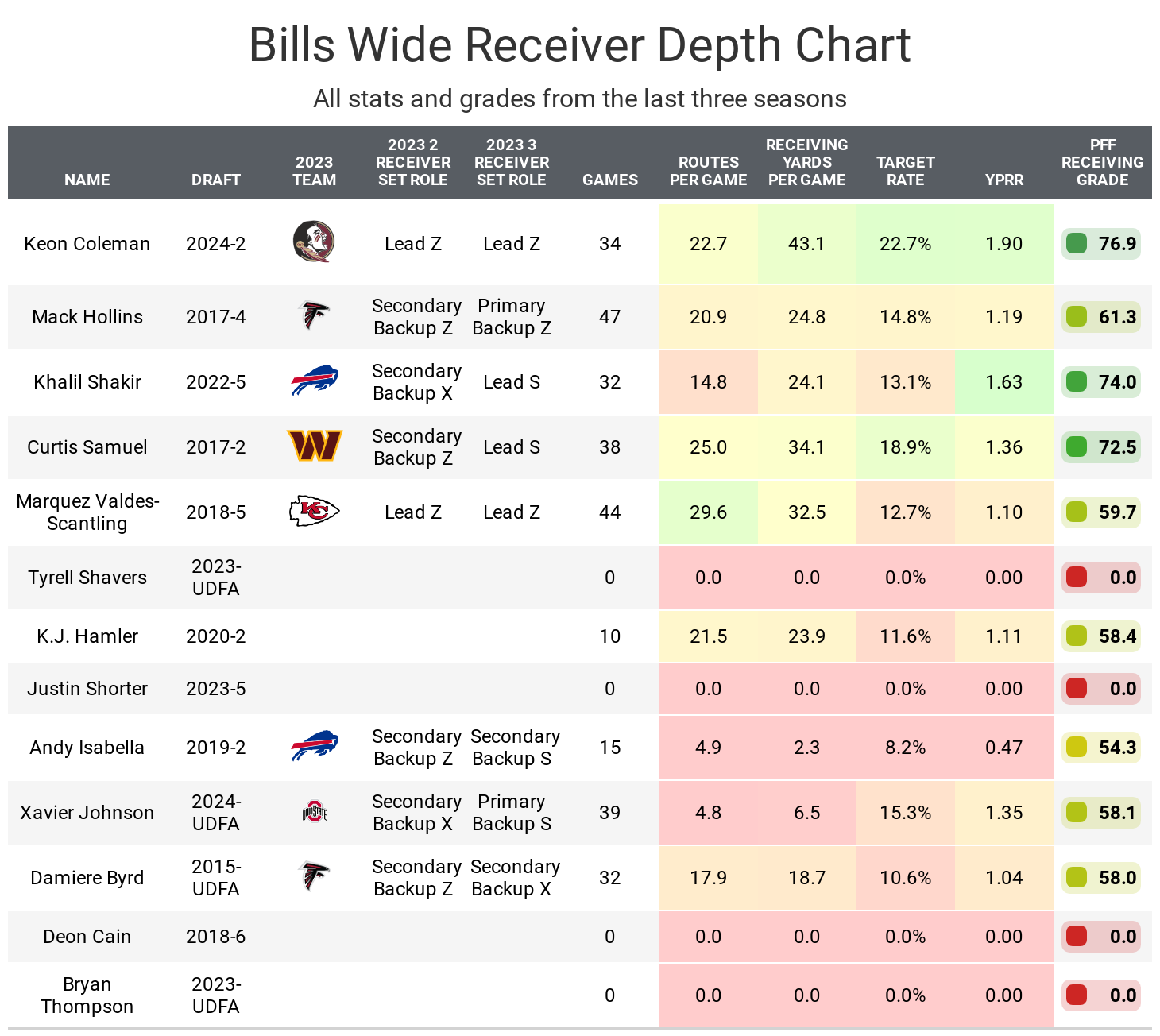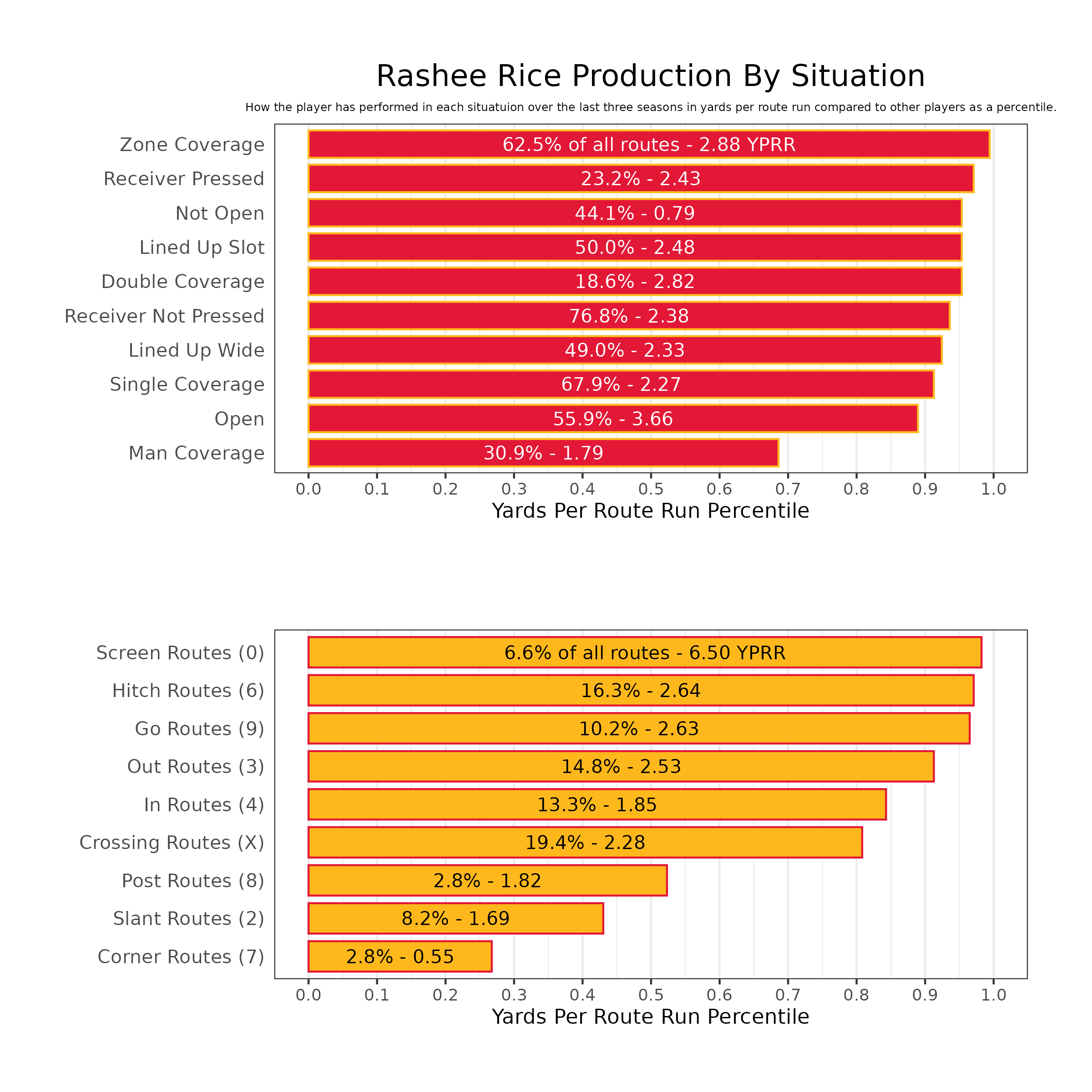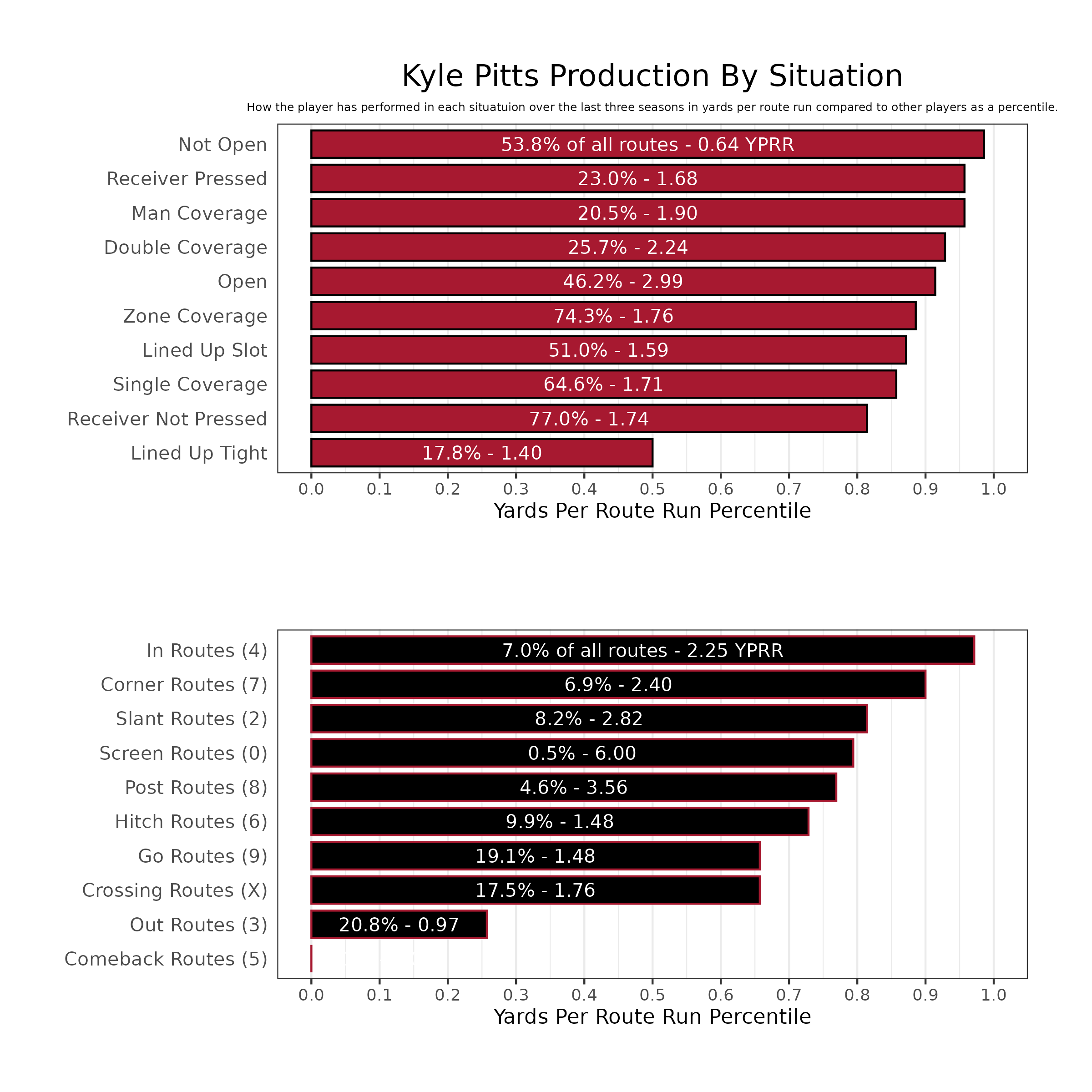• Josh Allen played well in Joe Brady’s offense: Joe Brady took over as the Buffalo Bills‘ offensive coordinator mid-season, and Allen averaged more points after the change.
• Rashee Rice was amazingly efficient for a rookie: Rice's performance on a per-play basis is comparable to that of elite NFL wide receivers.
• Dominate your fantasy draft: Subscribe to PFF+ to get full access to PFF’s suite of fantasy football tools, including the fantasy mock draft simulator, live draft assistant, fantasy draft rankings, cheat sheets and more! Click here to subscribe!
Estimated reading time: 9 minutes
It’s “my guy” season at PFF — time for us to plant our flags on players we like more than most. For my list, I simply picked the players that I’ve been most happy when I’ve been able to draft this season.
Josh Allen, Buffalo Bills (ADP: 3.02, from consensus ADP)
Allen finished first in fantasy points among quarterbacks in 2020, 2021 and 2023. He finished second in 2022, behind Patrick Mahomes, but still averaged an impressive 24.3 fantasy points per game. There are reports that the Bills could be more run-heavy with Joe Brady as offensive coordinator. They did run more often once Brady took over mid-season last year, but Allen still averaged 25.0 points per game over his final seven games after averaging 23.6 points without Brady.
Diggs stopped being a big factor in the offense once Brady took over. Diggs was WR4 last season beforehand and WR42 after. Buffalo spread the ball around more, with Khalil Shakir, Diggs, Dalton Kincaid, Gabe Davis and James Cook all gaining between 220 and 370 yards over those seven games. The team added Curtis Samuel, Keon Coleman, Mack Hollins and Marquez Valdes-Scantling to give them a variety of weapons.

Allen also became the team's clear rushing threat at the goal line. He ran five times from the one- or two-yard line, leading to five touchdowns. Bills running backs ran four times for one score. Before that, Allen ran just three times for two scores, whereas running backs ran eight times for three scores.
Ultimately, we’ve seen Allen in this offense when it deprioritized Diggs and ran the ball more, which ultimately led to his fantasy value going up. The unit did better in general, and he scored more touchdowns. It wasn’t great for the fantasy value of the receivers, but it was great for Allen. He should again finish as the top overall quarterback and has second-round value with a third-round ADP.
Joe Mixon, Houston Texans (ADP: 4.09)
The Cincinnati Bengals drafted Mixon in 2017, and he has averaged at least 80 yards per game since 2018 while becoming a bigger fantasy force over the past three seasons.
His rushing attempts per game declined in each of the past two seasons, but he made up for it with more receiving production. The now-former Bengal graded well, but his numbers haven’t always stood out on a per-play basis, in part due to his offensive lines. The Bengals' offense graded below average in run blocking in every season of Mixon’s career.
Mixon tends to play a very high percentage of snaps on early downs, at the goal line, in short-yardage situations and during two-minute drills. Running backs who do so, despite not playing on third downs, generally play close to as well as feature backs and score more points in standard leagues.
Last season, the Texans had similar running back roles to the Bengals. Devin Singletary played everything except third downs, while Dare Ogunbowale or Mike Boone would take the third-down snaps. Mixon is replacing Singletary on the roster. Both Dameon Pierce and Cam Akers made the roster as backups, and the two will likely play 20% of early-down snaps.
It’s even possible Mixon will take more third-down snaps than ever before. His only real competition for that work is Ogunbowale. The 30-year-old running back barely played the first half of the 2023 season and didn’t start seeing significant time until Week 13. Pierce and Akers have been solely early-down backs in their careers, just like Mixon, but Mixon has graded much better as a receiver.
Offensive coordinator Bobby Slowik recently said Mixon is “an absolute workhorse, in every regard.” The offenses Slowik has been part of generally run the ball more than average, which should continue to be true with Mixon. Going back to his 49ers days, Slowik's offenses typically had a clear early-down back and an every-down back with the right player, like Christian McCaffrey. This is all a great sign for Mixon's utilization this season.
Mixon has been a consistent top-12 fantasy running back in both total rank and points per game. Although he enters a new environment in 2024, he will again play in a high-scoring offense as the Texans' clear lead running back. While he’s never been the most explosive running back, it’s fair to think he will finish in the top 12 yet again.

Editor's note: For a more complete look at Mixon this season, check out his full player profile.
Rashee Rice, Kansas City Chiefs (ADP: 6.01)
Rice made an immediate impact in his first game, recording 29 yards and a touchdown on three receptions. Despite Kansas City's inconsistency at the position and Rice's impressive per-play performance, he didn't play more than 55% of the Chiefs' offensive snaps until Week 7.
Rice continued to excel on a per-play basis with this larger sample of snaps. By Week 14, he began receiving playing time comparable to a typical starting wide receiver, playing at least 75% of Kansas City's offensive snaps from Weeks 14-17. During this period, he ranked eighth in fantasy points among wide receivers. In the playoffs, Rice played at least 75% of Kanas City's offensive snaps in three of four games, averaging 6.5 receptions for 65.5 yards per game against some of the NFL's best defenses.
Rice is potentially facing a suspension following his arrest after a car accident. The most recent reports say he won’t be set on the commissioner’s exempt list or suspended until the legal situation plays out, which is unlikely to be finished this season. His ADP has begun skyrocketing on best ball platforms, while redraft platforms have slowly but surely started to catch up. He is the best value on some of those platforms at the moment.

Rice was used uniquely last season: He was the primary X receiver in two-receiver sets and the primary slot receiver in three-receiver sets. This is the best combination of roles a wide receiver can have; CeeDee Lamb is the only other receiver expected to have that role this season.
Rice's primary competition for targets remains Travis Kelce. The Chiefs retained most of their wide receiver rotation from last season, except for Marquez Valdes-Scantling and Richie James. They upgraded with Hollywood Brown and first-round pick Xavier Worthy, both of whom add speed and the ability to separate, likely leading to more deep passes. Fortunately, their skill sets differ enough from Rice's that they won't compete heavily for the same targets. The Chiefs have a history of easing in rookie wide receivers, as seen with Rice last year and Skyy Moore the year before, so we might not see much of Worthy early in the season.
Through two preseason games, Rice has played 23-of-24 snaps with the starters, including having six targets on 17 routes. If Rice can maintain his 25.5% target rate with increased snaps, it would be excellent for his fantasy value. However, it might decrease slightly as the Chiefs emphasize deep throws more often.
Rice finished as WR27 and was a top-36 wide receiver in nearly 70% of his games despite playing less than 70% of offensive snaps in all but four games. If you’re in a league where others haven’t fully kept up with the news, he is the easiest draft pick to make all draft regardless of where you’re picking in the fifth round.
Editor's note: For a more complete look on Rice this season, check out his full Player Profile.
Kyle Pitts, Atlanta Falcons (ADP: 5.11)
Pitts is a very talented tight end who has consistently underperformed in fantasy football. His 82.4 PFF receiving grade over the last three seasons is the fifth-best among tight ends, behind Travis Kelce, George Kittle, Mark Andrews and Dallas Goedert. His yards per route run average ranks sixth, behind those four and Sam LaPorta. His production in various situations also places him among the league's best tight ends. Although he is average when lined up at a specific tight end position, he does so less often than nearly all other tight ends.

Pitts' utilization has been a major problem. Last season, he played over 75% of Atlanta's offensive snaps in only two games, with a median of 64%. He was frequently rotated out, especially on early downs and even in 11 personnel, as the Falcons often used three or four tight ends in rotation. Arthur Smith’s offense was also very run-heavy, which left Pitts averaging around 27 routes per game.
Another problem has been where Pitts' targets come from. He has caught 72 of his 138 targets with a 10-plus-yard target depth, leading to 1,442 yards. Only Travis Kelce, George Kittle, Mark Andrews and Pitts have 70-plus receptions and 1,400-plus yards on such passes while all other tight ends have fewer than 55 receptions and under 1,000 yards in this range.
Conversely, Pitts has caught 77 of his 111 targets for 607 yards on sub-nine-air-yard targets thrown, ranking 23rd at the position in yards on those passes. He trails tight ends such as Tyler Conklin, Austin Hooper, Jonnu Smith, Darren Waller (who has been mostly injured) and Trey McBride (who has played in only two of the last three seasons). So, Pitts has not seen nearly enough short targets. Last season, Smith received more targets, receptions, and yards on shorter passes than Pitts.
Zac Robinson will now orchestrate the Falcons offense, which is a big reason for optimism regarding Pitts' role this season. With the Los Angeles Rams — where Robinson served as pass game coordinator and quarterbacks coach — Tyler Higbee was often the primary tight end. Despite missing some time in 2023, Higbee finished top-10 in routes run in both 2021 and 2022.
The other big improvement is in the quarterback position with Kirk Cousins. Pitts dealt with Desmond Ridder, Marcus Mariota and Taylor Heinicke at quarterback over the past two seasons—those signal-callers combined for a 54.5 PFF passing grade in that span, ranking second-worst in the NFL. The group recorded the eighth-highest rate of uncatchably inaccurate passes of 10 or more yards (38.4%). Meanwhile, new Falcons quarterback Kirk Cousins posted the third-best rate (29.0%) over that span.
We expect Atlanta to have one of the largest improvements in team passing grade this season. Atlanta's figure finished at 49.4 last season, and Cousins' worst season of the past six years is 76.1.
Everything points to Pitts putting up better numbers this season if he can stay healthy. There is some uncertainty with the new offensive playcaller, new quarterback, and the limited sample size of tight ends as young as Pitts entering their fourth season. Pitts should be a clear fantasy starter this season, but he will need to find the red zone more often to break into the top five or higher. If everything goes right, he has the potential to be the overall TE1.
Taysom Hill, New Orleans Saints (ADP: 17.06)
Hill has been one of the most intriguing players in fantasy football for years. In 2020, he started four games at quarterback when Drew Brees was injured and averaged 21.6 points per game, primarily due to his rushing production.
Leading up to those games, most fantasy websites listed him as a tight end, which sparked debates about whether he should retain tight end eligibility. Similarly, in 2021, Hill started at quarterback from Week 13 to 17, where he averaged 19.5 points per game.
Currently, Hill's positional eligibility varies across platforms: ESPN and Sleeper had him with duel eligibility at both quarterback and tight end from the start of the offseason. Yahoo! recently gave him duel eligibility after seeing his preseason usage. My Fantasy League lists him solely as a quarterback.
In 2022, Hill primarily saw action at quarterback, often in wildcat formations. However, in 2023, his role shifted more towards tight end. He lined up 80 times in a traditional tight end stance, 130 times in the slot, 71 times out wide, 115 at quarterback and 29 in the backfield. Hill also recorded a career-high 33 receptions last season.
The Saints still list Hill as a quarterback on their roster and depth chart, primarily due to the emergency third quarterback rule. Given his unique alignment distribution, there’s no definitive answer to what position he should be labeled as, since no other player has a role quite like his. ESPN's approach of granting him eligibility at multiple positions in fantasy football seems to be the most fitting, reflecting the various positions he plays in real life.
For the past seven seasons, Pete Carmichael has been Hill's offensive coordinator, with Sean Payton as his head coach for most of that time. It seemed unlikely that Klint Kubiak would use the soon-to-be 34-year-old in the same way as his previous coaches. However, through two preseason games, it appears that Hill might be used even more than before.
In the Saints' first preseason game, Hill was utilized more as a receiver, playing each of the first six snaps in various positions: two snaps out wide, one in the slot, two at tight end, and one in the backfield.
In the second preseason game, Hill started at halfback over Jamaal Williams, taking six snaps at tight end, four at halfback, four at fullback, and one in the slot. He played 14 of 22 snaps with the starters, ran the ball five times, and scored a touchdown. While it's important to note that the Saints were without Alvin Kamara and Juwan Johnson in this game, Hill's versatile performance remains impressive.
Hill, the team’s highest-graded rusher, averaged 5.0 yards per attempt in 2023, a full yard more than any of their top three running backs. He finished 2022 with the ninth-most fantasy points among tight ends and 2023 with the 12th-most.
Hill could rank even higher this year if his preseason usage carries into the regular season.





 © 2025 PFF - all rights reserved.
© 2025 PFF - all rights reserved.